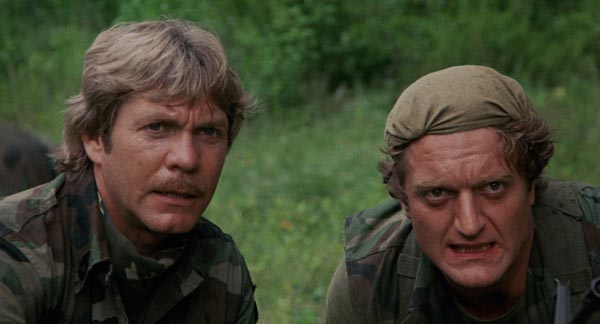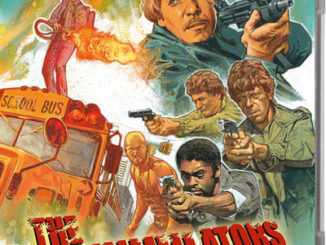
With the release of Arrow Video’s The Annihilators, read film historian and author Chris Poggiali’s introduction into New World Pictures – Roger Corman’s now legendary cult movie production company that brought it to life.
When Roger Corman cut the ribbon on New World Pictures in May of 1970, he was in the right place at the right time with the right idea in mind for his latest business venture: a production and distribution company that would provide a training ground for young filmmakers eager to get into the business. Less than a year after the release of Easy Rider, every studio in town was trying to duplicate its success by seeking out independent filmmakers with an eye on the youth market and all things counterculture. This was the height of the New Hollywood era, which Corman himself had helped usher in with his trailblazing 1966 smash The Wild Angels. Mostly known as a producer-director, the indie exploitation auteur could also include “distributor” among his hyphenates thanks to Filmgroup, the short-lived outfit he and his brother Gene had started a decade earlier to release low-budget double features to the drive-in circuit. He also had a reputation for discovering and nurturing new talent, both in front of and behind the camera: Jack Nicholson, Robert Towne, Francis Ford Coppola, Peter Bogdanovich, and Ellen Burstyn are just a few of the people who were able to get a foot in the door thanks to Corman’s knack for spotting a winner.
Sex and violence of the R-rated variety was what drive-in audiences craved and New World found immediate success with its first five releases, two of which – The Student Nurses and The Big Doll House – were trendsetters in addition to being box-office hits. With budgets in the $120,000-$130,000 range it’s no wonder New World could claim a pre-tax profit of $3.2 million by the end of their first year of operation. Because the northern United States had a short drive-in season, Corman began buying foreign films that could play hardtop theaters during the winter months. Newer works by such world-renowned filmmakers as Bergman, Fellini, Truffaut, and Kurosawa soon appeared on release schedules beside titles like Scream of the Demon Lover and Candy Stripe Nurses. A sort of branding occurred with the lurid advertising of the exploitation films, as Ron Gans usually narrated the trailers and most of the poster art after 1972 was done by John Solie. Everything you needed to know about the movies could usually be gleaned from the tag lines (“See stewardesses battle kung fu killers!”). A stock company of performers took shape: David Carradine, Candice Rialson, Dick Miller, Mary Woronov, Paul Bartel and others became familiar faces. As budgets increased, bigger stars signed on to appear in productions that now had more to offer than just sex and violence. Car crashes, creature features, karate and the cosmos replaced bikers, blaxploitation, nurse movies and women’s prisons. There were several network TV deals. Martin Scorsese, Jonathan Demme, Ron Howard, Joe Dante, John Sayles, Gale Anne Hurd, James Cameron and others made their mark and moved on to greener pastures.

By 1980, New World controlled 60% of the independent market, with branch offices in twelve cities including Chicago, Philadelphia, Dallas, Charlotte and Denver. Budgets were now in the low millions, with Battle Beyond the Stars and Smokey Bites the Dust expected to compete with The Empire Strikes Back and The Cannonball Run in malls and multiplexes. American International, Dimension, Avco Embassy – one by one, Corman’s competition was disappearing. Drive-ins were closing. Cable television and home video were replacing theatrical exhibition as the major outlet for the independent product that New World had been pushing up to that point. Looking to exit the distribution side of the business sooner rather than later, Corman sold the company in early 1983 to concentrate on production and an eventual return to directing, but within two years he was back in distribution with a new company, Concorde Pictures. The new owners of New World, meanwhile, found their biggest success with House, the Hellraiser movies, Creepshow 2, Flowers in the Attic, and Soul Man.
Anyone interested in learning more about New World Pictures is encouraged to seek out Christopher T. Koetting’s book Mindwarp! The Fantastic True Story of Roger Corman’s New World Pictures as well as the earlier BFI Dossier Number 7: Roger Corman’s New World by Jim Hillier and Aaron Lipstadt. After The Student Nurses and The Big Doll House, the following New World films (and their tell-all taglines) are recommended.
The Big Bird Cage (1972) – “Women so hot with desire they melt the chains that enslave them!” A faster, funnier follow-up to The Big Doll House, reuniting stars Pam Grier and Sid Haig in the Philippines with director Jack Hill.
The Student Teachers (1973) – “They can teach you a lot… Enter their course!” The makers of Night Call Nurses exchange the hospital for high school.
Caged Heat (1974) – “Women’s prison U.S.A. – rape, riot & revenge.” Future Oscar winner Jonathan Demme made his directorial debut with this homegrown women’s prison movie featuring Erica Gavin, Barbara Steele and Rainbeaux Smith.
Big Bad Mama (1974) – “Wilma gave her daughters everything – her looks, her lovers, and the crime of their lives!” Corman’s second Depression era ‘mama’ movie (following Bloody Mama) stars Angie Dickinson and William Shatner.
Death Race 2000 (1975) – “In the year 2000 hit and run driving is no longer a felony. It’s the national sport!” Satirical Rollerball cash-in co-starring future Oscar winner Sylvester Stallone.
Hollywood Boulevard (1976) – “The streets where starlets are made!” Joe Dante and Allan Arkush, who worked in New World’s trailer department, constructed this $60,000 comedy around footage from other New World movies.
Jackson County Jail (1976) – “The cops are there to protect her. But who are there to protect her from the cops?” This was New World’s first critical success, written by future Oscar winner Donald Stewart and starring Yvette Mimieux, Tommy Lee Jones and Mary Woronov. Look for the paperback novelization and the made-for-TV movie version (Outside Chance).
Grand Theft Auto (1977) – “See the greatest cars in the world destroyed: Rolls Royce, Cadillac, Lincoln, Mercedes, Porsche and 43 screaming street machines!” TV star Ron Howard’s second car crash comedy for New World was his first directorial effort and also a family affair: he co-wrote the screenplay with his father Rance Howard and his brother Clint has a supporting role. Twenty-five years later, he was awarded the Academy Award for Best Director (A Beautiful Mind).
Piranha (1978) – “Lost River Lake was a thriving resort – until they discovered…” Shot in 22 days, Joe Dante’s directorial effort has more in common with the creature features of the fifties than Spielberg’s big hit of ’75, but was released to compete with Jaws II. Just when you thought it was safe to go back to the drive-in…
Rock ‘n’ Roll High School (1979) – “Will your school be NEXT?” A teen cult comedy featuring the Ramones, from a story by Joe Dante and Allan Arkush, starring P.J. Soles, Mary Woronov, Paul Bartel, Clint Howard, Dick Miller… The colorful, chaotic poster design by William Stout calls to mind Rick Meyerowitz’s art for the previous year’s hit comedy Animal House.
———-
Join the New World with Arrow Video’s lovingly restored editions of Corman’s films, from The Annihilators to Hellraiser.



Be the first to comment